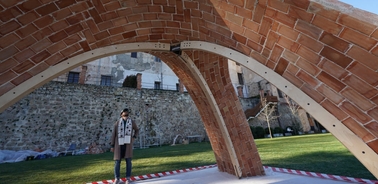- Home
- News And Events
- News
- Architects From Ie University And Princeton University Build A Vaulted Pavilion Using Augmented Reality In Segovia
Architects from IE University and Princeton University build a vaulted pavilion using augmented reality in Segovia

The project is led by Syrian-Spanish architect and IE School of Architecture and Design professor Wesam Al Asali.
For the last week, Architects from IE School of Architecture and Design and Princeton University (USA) have been building a domed pavilion using artificial intelligence, holograms, augmented reality and a custom-made construction system at IE University's historic campus in Segovia.
The project, which involves architects, engineers, craftsmen and IE University students, is led by Syrian-Spanish architect and IE School of Architecture and Design professor Wesam Al Asali, along with Sigrid Adriaenssens, director of the Form Finding Lab at Princeton University.
The team of experts will use ground-breaking holographic techniques to create a brick vault structure built without the need for formwork, a type of arch common in Spain, whose origin dates back to the Middle Ages.
Experts from IE University and Princeton University, together with Salvador Gomis Aviño, a Valencian master builder with more than 20 years of experience in the construction of handcrafted arches, are erecting the open-air vaulted brick pavilion using a three-meter high tripod that is five meters long and three meters wide that combines traditional construction techniques with advanced methods of artificial intelligence and digital technology.
The pavilion will have a first layer of industrial hollow bricks, faced with tiles. Augmented reality glasses and Microsoft's HoloLens app have been used in the process of laying the bricks, allowing builders to follow holographic guides and the exact placement of the bricks, thus affording greater efficiency in construction.
“AR technology allows the craftsman to work faster and more efficiently and accurately, and by using computational analysis, construction patterns can be generated for future projects and elevate the traditional skills of craftsmen to other levels,” explains Professor Al Asali, pointing out: “the technology allows us to visualize the lines that the structure follows with great precision before building it, brick by brick.” This method, he says, “saves a lot of materials for making the mold, guides and formwork for the vault, and also helps us to better understand how a building behaves during construction.”
Digital innovation
These types of techniques make it possible to develop more sustainable construction solutions and to combine traditional manufacturing methods with the latest digital innovations in architecture.
“Engineers and architects send the plans to the builders, then supervise their work. With this model, construction is democratized by putting all the actors in the same physical and digital space,” says Al Asali, an expert in heritage policy, craftsmanship and local materials in construction, who has worked in Europe and the Middle East. In addition to practicing the technique with the master builder, IE University architecture students will design small-scale replicas of the pavilion, which will allow them to study the secrets of the structure in detail.
Sustainable construction
The bricks used in the project were manufactured and provided by La Paloma Cerámicas. The use of locally sourced materials and traditional construction methods, as well as its sustainable nature, mean that the pavilion meets United Nations Sustainable Development Goals, which include the fight against climate change, the defense of the environment or the design of cities. In turn, the project is aligned with the New European Bauhaus, an initiative of the European Commission for sustainable architecture in the EU that aims to improve quality of life.
IE School of Architecture and Design and Princeton University have been working on the study of the building trades as sustainable alternatives for today's environment since 2022. The initiative is a joint effort led by Wesam Al Asali and Sigrid Adriaenssens. The team from both universities is investigating the potential of the intersection of traditional building crafts with engineering technology as a possible pathway to low-carbon, environmentally friendly architecture. The collaboration is supported by the Faculty Initiative Fund of Princeton's Institute for International and Regional Studies. The joint program includes exchange opportunities for graduate students and faculty, as well as an online lecture series.